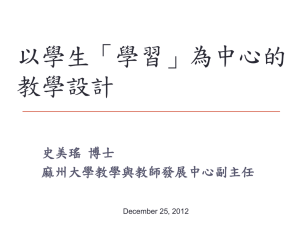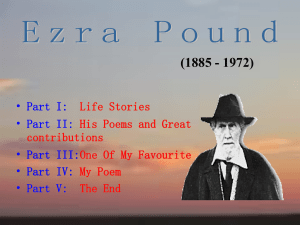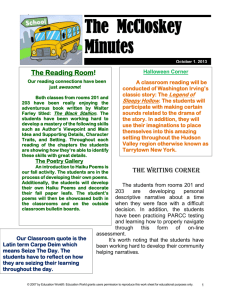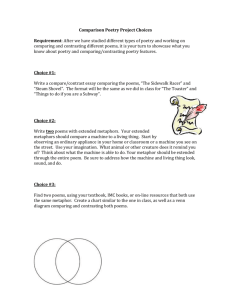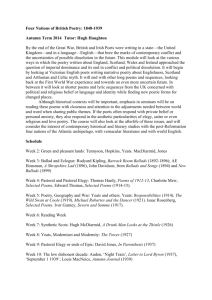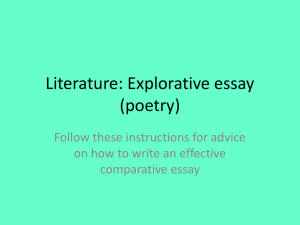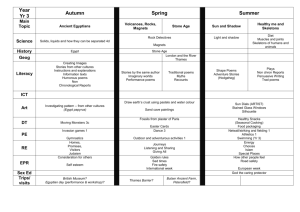725-01. Cuda
advertisement
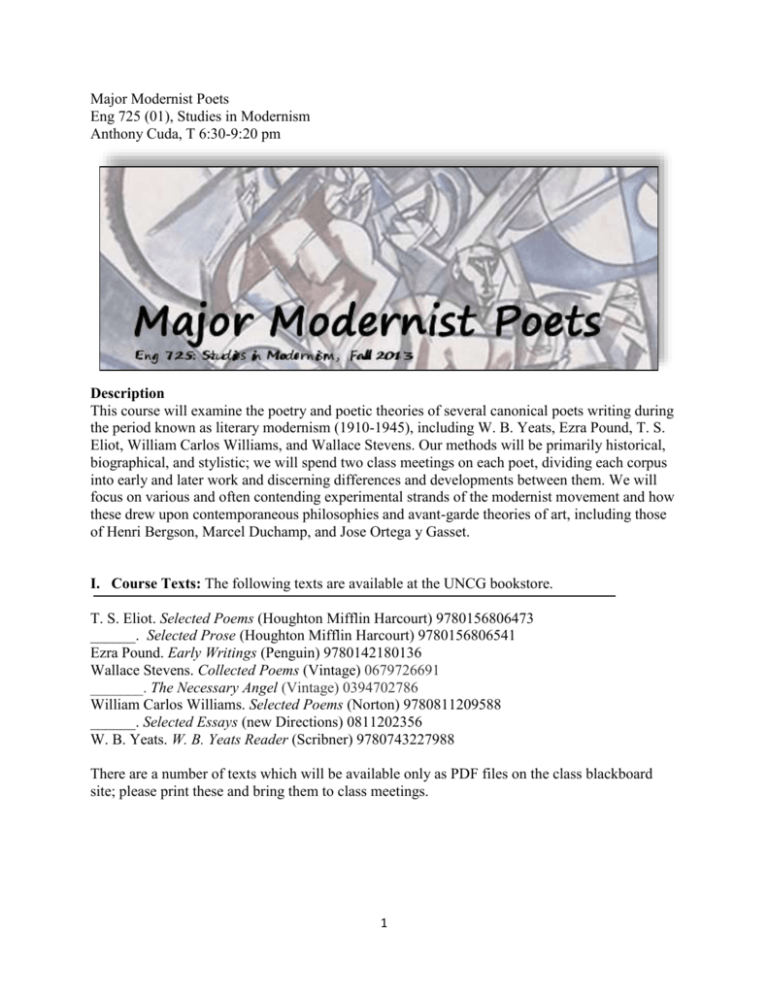
Major Modernist Poets Eng 725 (01), Studies in Modernism Anthony Cuda, T 6:30-9:20 pm Description This course will examine the poetry and poetic theories of several canonical poets writing during the period known as literary modernism (1910-1945), including W. B. Yeats, Ezra Pound, T. S. Eliot, William Carlos Williams, and Wallace Stevens. Our methods will be primarily historical, biographical, and stylistic; we will spend two class meetings on each poet, dividing each corpus into early and later work and discerning differences and developments between them. We will focus on various and often contending experimental strands of the modernist movement and how these drew upon contemporaneous philosophies and avant-garde theories of art, including those of Henri Bergson, Marcel Duchamp, and Jose Ortega y Gasset. I. Course Texts: The following texts are available at the UNCG bookstore. T. S. Eliot. Selected Poems (Houghton Mifflin Harcourt) 9780156806473 ______. Selected Prose (Houghton Mifflin Harcourt) 9780156806541 Ezra Pound. Early Writings (Penguin) 9780142180136 Wallace Stevens. Collected Poems (Vintage) 0679726691 _______. The Necessary Angel (Vintage) 0394702786 William Carlos Williams. Selected Poems (Norton) 9780811209588 ______. Selected Essays (new Directions) 0811202356 W. B. Yeats. W. B. Yeats Reader (Scribner) 9780743227988 There are a number of texts which will be available only as PDF files on the class blackboard site; please print these and bring them to class meetings. 1 II. General and Particular Requirements: 1 presentation Participation 1 7-10 pp. mid-term essay 1 15-20 pp. final essay 5% 5% 40% 50% Presentation (5%): Each student will have the opportunity to speak for 5 minutes about a topic pertinent to the readings and assigned by the instructor. Further instructions will be distributed. Mid-term essay (40%): The 7-10 pp. midterm essay is an exercise in contextual research; it will focus upon a single poem by an author on our syllabus. You must choose a poem that first appeared in a periodical and indicate the original publication data at the beginning of the essay, directly beneath the title. To enrich and illuminate your discussion of the poem, you must draw upon the following sources: (1) adjacent poems or prose from the periodical issue in which the poem first appeared; (2) material from at least two other periodicals published in the same year, at least one of which must be an exclusively literary or artistic publication; (3) at least one play (by any author, living or dead) performed in the same year; (4) at least two letters composed by the author within a span of two years from the date of the poem’s publication; (5) at least one piece of non-fiction prose composed by the author within the same time span; (6) two other poems published by the author within 5 years. Papers should conform to either Chicago or MLA style format and should include bibliography or works cited. Final essay (50%): The 15-20 pp. final essay shall focus on a topic of your choosing and follow the standard practices and guidelines for graduate seminar research papers, which we will discuss further in class. Part of the grade will derive from your delivery of a brief oral presentation of the project’s aims and scope during the last class of the semester. III. Schedule of Readings For each class session, students should read the primary text by the author under consideration in its entirety and then return to pay particular attention to the individual poems listed below. 20-Aug Introduction Bradbury and McFarlane, “The Name and Nature of Modernism” (PDF) Whitworth, “Introduction,” Modernism (Blackwell Guides) (PDF) 27-Aug Early Yeats Poems, pp. 3-55, Focus, "The Song of the Happy Shepherd," "The Sad Shepherd," "The Lake Isle of Innisfree," “The Song of Wandering Aengus,” “The Magi”; plays, “On Baile’s Strand,” pp. 166-191; Critical Writings, pp. 363-403, Focus: “Magic,” “The Symbolism of Poetry.” Secondary: Marjorie Howes, “Introduction,” and George Watson, “Yeats, Victorianism, and the 1890s,” from Cambridge Companion to W. B. Yeats. 2 Optional: Dennis Denisoff, “Decadence and Aesetheticism,” Cambridge Companion to the Fin de Siècle. 3-Sep Early Pound Early Writings: poems, pp. 1-90, Focus: “Revolt,” “Exile’s Letter,” “In a Station of the Metro,” “The Encounter,” “L’Art, 1910.” Prose, pp. 187-296, Focus: “Psychology and Troubadours,” “Imagisme,” “A Restrospect,” “Vorticism.” Secondary: Jacob Korg, “Imagism,” from A Companion to Twentieth-Century Poetry (Blackwell); Hugh Witemeyer, “Early Poetry 1908-1920,” Cambridge Companion to Ezra Pound; Herbert N. Schneidau, “Pound and Yeats: The Question of Symbolism.” Optional: Joann Gardner, “Yeats, Pound, and the Inheritance of the Nineties”; George Bornstein, “Ezra Pound and the Making of Modernism.” 10-Sep Early Eliot Selected Poems, pp. 11-47, Focus: “The Love Song of J. Alfred Prufrock”; “Portrait of a Lady.” Selections from Inventions of the March Hare (PDF); Selected Prose, pp. 31-59; 149-153, Focus: “Tradition and the Individual Talent,” “Hamlet,” + PDFs of the following: “Verse Pleasant and Unpleasant,” “Eeldrop and Appleplex,” “Rhetoric and Poetic Drama.” Secondary: Anthony Cuda, “The Poet and the Pressure Chamber: Eliot’s Life”; Frances Dickey, “Prufrock and Other Observations: A Walking Tour,” both from Companion to T. S. Eliot (Blackwell). 17-Sep Early Stevens Harmonium (1923), pp. 3-113. Focus: “The Snow Man,” “Disillusionment of Ten O’clock,” “Sunday Morning.” Secondary: Sukenick, “Wallace Stevens: Theory and Practice,” Musing the Obscure (1967); Joan Richardson, “Wallace Stevens: a likeness” and Robert Rehder, “Stevens and Harmonium,” both from Cambridge Companion to Wallace Stevens. 24-Sep Early Williams Selected poems, pp. 1-136, Focus: “Advent,” “St. James’ Grove,” “Pastoral,” “Spring and All,” “The Red Wheelbarrow,” “This is Just to Say,” “The Yachts”; also “TheYoung Housewife” and “Danse Russe” (2 PDFs). Selected Essays, pp. 1-120, Focus: “Prologue to Kora in Hell.” Secondary: Henry Sayre, “Ready-Mades and Other Measures: The Poetics of Marcel Duchamp and William Carlos Williams,” Journal of Modern Literature (1980). Additional article TBA. 3 1-Oct Impersonality Wilhelm Worringer, from Abstraction and Empathy (PDF); Ortega y Gasset, from The Dehumanization of Art (PDF). 8-Oct T. E. Hulme and the revival of classicism T. E. Hulme, “Cinders,” “Romanticism and Classicism,” “Preface to Sorel’s Reflections on Violence”; Helen Carr, “T. E. Hulme and the ‘Spiritual Dread of Space” (PDF). 15-Oct Fall break 22-Oct Later Yeats Poems, pp. 56-151, Focus: “The Second Coming,” “Sailing to Byzantium,” “Leda and the Swan,” “Byzantium,” “Lapis Lazuli,” “The Circus Animals’ Desertion”; plays: pp. 219-229, 267-280; critical writings, pp. 404-439, Focus: “Per Amica Silentia Lunae” Secondary: Thomas Rees, “Ezra Pound and the Modernization of W. B. Yeats,” Journal of Modern Literature (1975); Helen Vendler, “The Later Poetry,” Cambridge Companion to W. B. Yeats (2007). 29-Oct Later Pound Early Writings: poems, pp. 98-184, Focus: “Hugh Selwyn Mauberley,” “Three Cantos of a Poem of Some Length” + Cantos I-III (PDF). Prose, pp. 292-329, Focus: “The Chinese Character as a Medium for Poetry.” Secondary: K. K. Ruthven, commentary on “Hugh Selwyn Mauberley,” from A Guide to Ezra Pound’s Personae (1969); John Foster, “Pound’s Revision of Cantos I-III.” 5-Nov Later Eliot Selected Poems, pp. 51-104, Focus: The Waste Land, Ash-Wednesday. Selected Essays, pp.59-131, 153-238, Focus: “The Metaphysical Poets,” “Ulysses, Order, and Myth,” “Dante.” Secondary: Grover Smith, “Memory and Desire: The Waste Land”; Maud Ellmann, “The Waste Land: A Sphinx without a Secret.” 12-Nov Later Stevens Ideas of Order and The Man with the Blue Guitar (1936) pp. 117-188; Parts of a World, pp. 191-284; Transport to Summer, pp. 285-410. Focus: “The Idea of Order at Key West,” “The Poems of Our Climate,” “Landscape with Boat,” “Notes toward a Supreme Fiction.” The Necessary Angel (all), Focus: “The Noble Rider and the Sound of Words.” 4 Secondary: Milton Bates, “Stevens and the supreme fiction,” Cambridge Companion to Wallace Stevens; David Bromwich, “Destruction and the Theory of Happiness in the Poetry of Yeats and Stevens.” 19-Nov Later Williams Selected poems, pp. 136-297, Focus: “A Sort of a Song,” “Paterson: The Falls,” “Landscape with the Fall of Icarus,” Paterson, excerpts from Book One; Selected Essays, pp. 121-314, Focus: “Revelation,” “The Poem as a Field of Action.” Secondary: TBA 26-Nov Last class IV. Expectations and Guidelines for graduate seminar work 1. Reading and note-taking, primary sources Read all primary source material slowly, repeatedly, and with sustained and singular attention. If dealing with collections of poetry, I recommend reading individual volumes at a time, before returning to poems of particular interest. If collection is not separated by original volumes (as in some “selected” editions), take careful note of publication dates of poems and keep chronology in mind. Take note of continuities and discontinuities between poems and between volumes, including recurrent phrases, images, symbols, literary techniques and conventions. Make note of significant changes in style and theme between volumes and between sets of poems. When rereading individual poems, jot down paraphrases, salient phrases and tropes, and brief interpretative readings of the poem’s movements. Define and look up etymology for all unfamiliar or seldom used words and phrases. 2. Reading and note-taking, secondary sources Read all secondary source material as thoroughly as necessary to reformulate the author’s central claim in your own language and to recall the most salient evidence that the author uses to support that claim. Take active, synthetic notes as opposed to passive, reproductive notes, which simply repeat phrases and ideas directly from the source. Active note-taking often means formulating categories to help you take standard, uniform notes on each essay—like author, date, central claim, primary evidence, theoretical underpinnings, presuppositions, possible shortcomings—so that they can be quickly compared and consulted during class discussion. Force yourself to keep these notes relatively brief and to keep your language simple and concise in recapitulating them. Do at least basic research on any significant names or concepts with which you are unfamiliar; “Literature Resource Center” on-line databases through UNCG’s library and reference books like the Princeton Encyclopedia of Poetry and Poetics and M. H. Abrams’s Glossary of Literary Terms are useful for this purpose. 5 3. Preparing for class discussion Especially if you have read the material over the course of the preceding week, preparing adequately for class discussion means first reviewing all notes you’ve taken on the reading. Actively assemble and think through the networks of ideas and verbal associations as they form across the various texts. Be prepared to offer detailed readings of individual poems upon which we’ll focus and be ready to support your conclusions with evidence from other poems and prose under consideration that session. As time permits, I highly recommend pursuing additional secondary research into themes and persons of interest, especially given the ease with which such research can be performed via on-line scholarly resources. In reviewing, consider what each secondary source might contribute toward our grasp of each focus poem, even if that source does not address it directly. Participation in class discussion is essential to your success in the class; if you do not participate regularly, I will assume that you have not finished the reading. 6

